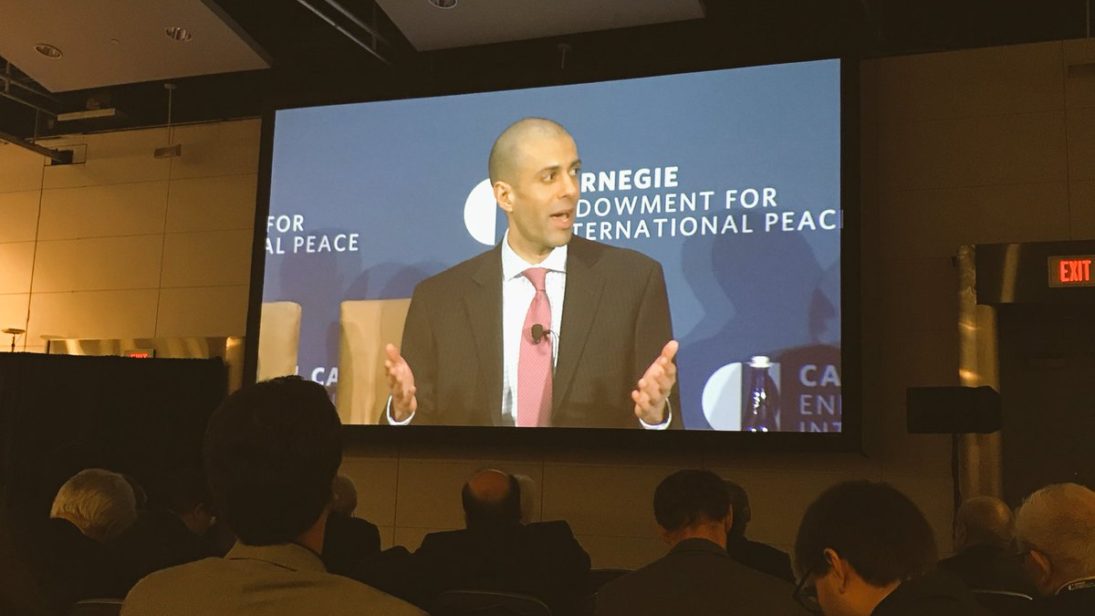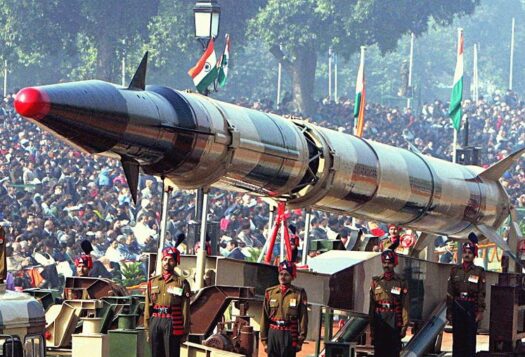
At the 2017 Carnegie International Nuclear Policy Conference in Washington D.C., Prof. Vipin Narang, an expert on South Asian nuclear strategy at the Massachusetts Institute of Technology, created waves with his statement that India may abandon its no first use policy and launch a preemptive counterforce strike against Pakistan if it believed that Pakistan was going to use nuclear weapons (likely tactical nuclear weapons) against it. His assessment is based on the statements and writings of former Indian government and military officials. This assessment was recently picked up in Ajai Shukla’s well-regarded column on strategic affairs in India’s Business Standard.
Read Vipin Narang’s Remarks Below
SAV contributors debate:
1. No Shift in India’s NFU Policy by Ruhee Neog
2. Indian Rethink on NFU? Not a Surprise to Pakistan by Muhammad Faisal
3. India’s Nuclear Doctrine Needs to be Debated by Tanvi Kulkarni
4. To Use or Not To Use: India’s Fractured NFU by Saima Sial
Remarks by Professor Vipin Narang, Department of Political Science, Massachusetts Institute of Technology*
“Plenary: Beyond the Nuclear Threshold: Causes and Consequences of First Use” Carnegie International Nuclear Policy Conference
Washington, DC, March 20, 2017
(Remarks as prepared, not as delivered)
Everybody thinks they know the likeliest pathway to nuclear first use in South Asia. It is called a conventional wisdom for a reason. It starts with a terrorist attack presumed to be from Pakistan on an Indian metropole that kills scores of civilians. Unable to exercise restraint anymore due to domestic political pressures baying for blood, the Government of India orders the mobilization of its three main strike corps and commences offensive operations across the international border, not limiting its response to the Jammu and Kashmir sector and the Line of Control. The deepest thrust is undertaken by XXI Corps and its supporting elements in the desert sector. XXI Corps threatens to bisect Pakistan’s north- south communications, putting Pakistani conventional forces on its heels. Unable to slow down XXI Corps, Pakistan flushes out Nasr tactical nuclear weapons batteries or Abdali missiles and its Strategic Plans Division (SPD) authorizes their use either in demonstration shots, against concentrated XXI Corps armored divisions, or bridgeheads and logistics behind the main thrust to slow down the Indian offensive. India then promises what most presume is massive countervalue retaliation against Pakistani cities, leaving aside how credible or incredible that might be.
This is how nuclear first use would unfold in South Asia, right? Well, maybe not so fast. There is increasing evidence that India will not allow Pakistan to go first. And that India’s opening salvo may not be conventional strikes trying to pick off just Nasr batteries in the theater, but a full ‘comprehensive counterforce strike’ that attempts to completely disarm Pakistan of its nuclear weapons so that India does not have to engage in iterative tit-for-tat exchanges and expose its own cities to nuclear destruction. This thinking surfaces not from fringe extreme voices such as Bharat Karnad or retired Indian Army officers frustrated by the lack of resolve they believe their government has shown in multiple provocations, but from no less than a former Strategic Forces Command C-in-C Lt Gen BS Nagal and, perhaps more importantly and authoritatively, from the highly respected and influential former National Security Advisor Shivshankar Menon in plain sight in his recent 2016 book Choices: Inside the Making of Indian Foreign Policy. In short, we may be witnessing what I call a ‘decoupling’ of Indian nuclear strategy between China and Pakistan. The force requirements India needs in order to credibly threaten assured retaliation against China may allow it to pursue more aggressive strategies—such as escalation dominance or a ‘splendid first strike’—against Pakistan. We may be seeing the emergence of this decoupling, or at least serious mainstream thinking about it, with the intention being a disarming strike against Pakistan.
But wait, you say, doesn’t Indian official nuclear doctrine and posture clearly espouse a No First Use Doctrine and threaten massive countervalue retaliation? Well as Scott Sagan and others, including myself, have pointed out the sanctity of India’s NFU is already eroded in the official doctrine by threatening nuclear use against chemical and biological weapons. And the doctrine is silent about targeting, only threatening massive retaliation designed to inflict unacceptable damage. This could be countervalue, and has long been presumed to be….but it does not have to be.
Could all this be changing? Indeed, as Shivshankar Menon recently stated: “India’s nuclear doctrine has far greater flexibility than it gets credit for.”
First, although Menon ultimately concludes that No First Use is in India’s strategic interests, he further undermines its sanctity when he writes the following:
“There is a potential gray area as to when India would use nuclear weapons first against another NWS. Circumstances are conceivable in which India might find it useful to strike first, for instance, against an NWS that had declared it would certainly use its weapons, and if India were certain that adversary’s launch was imminent.”[1]
In practice, this scenario could open the door for India to initiate preemptive nuclear use if, for example, it detected Pakistan moving tactical nuclear weapons batteries into the theater of battle. No matter how imminent their use may actually be, Indian security managers would have no choice but to assume intent to use at that point. And the declaration of certain use in these scenarios has already been enunciated by SPD. This dovetails with writings of former SFC C-in-C Nagal who questioned the morality of NFU, particularly in a democratic state like Indian—asking how the Indian leadership could accept significant casualties if it knew a nuclear use by Pakistan were imminent. In November 2016, the sitting defense minister at the time, Manohar Parrikar, stated in his “personal capacity”—insofar as that is even possible—that India should not declare one way or another whether it in fact has a no first use policy. Increasingly, it is clear that serious national security officials in India have every intention of moving away from it: Menon clearly carves out an exception for preemptive Indian first use in the very scenario that is most likely to occur in South Asia. Indian leaders can disavow all of this as personal opinions, but when a sitting defense minister, former Strategic Forces commander, and highly respected NSA all question the sanctity of NFU, it all starts to add up.
More interestingly, Menon elucidates what the nature of Indian first use might be. First, he refers to countervalue targeting in the past tense: “Instead, the logical posture at first was counter-value targeting, or targeting an opponent’s assets, rather than counterforce targeting, which concentrates on the enemy’s military and command structures.” Implying, perhaps, that the current strategy has shifted away from countervalue targeting to counterforce. Then, in a paragraph, which had, as far as I can tell, been missed by India nuclear doctrine watchers until now, he further writes:
“What would be credible would be the message India conveyed by how it configures its forces. If Pakistan were to use tactical nuclear weapons against India [or believed to imminently prepared to do so], even against Indian forces in Pakistan, it would effectively be opening the door to a massive Indian first strike, having crossed India’s declared red lines. There would be little incentive, once Pakistan had taken hostilities to the nuclear level, for India to limit its response, since that would only invite further escalation by Pakistan. India would hardly risk giving Pakistan the chance to carry out a massive nuclear strike after the Indian response to Pakistan using tactical nuclear weapons. In other words, Pakistani tactical nuclear weapons use [or imminent use] would effectively free India to undertake a comprehensive first strike against Pakistan.”[2]
Make no mistake, he is talking about completely disarming Pakistan in the Indian strike so that it had no ability to retaliate in a ‘third strike’ against Indian high value targets. In combination, these paragraphs suggest that the party that goes first in the most likely pathway to nuclear first use in South Asia may not be Pakistan, but India, if and when it believed that Pakistan might be ready to cross the nuclear threshold. The nature of that first use might be a full attempted counterforce strike against Pakistan’s strategic nuclear capabilities, and whatever tactical capabilities it could find. With such a strategy, in fact, India could not afford to go second and risk any attrition of its own forces. But knowing this, Pakistan has every incentive to go first and go massively itself…emplacing South Asia into the very definition of first strike instability.
Can India do this now? Almost certainly not. There is little evidence that it can find, fix, and destroy Pakistan’s nuclear forces in real time on land (we can talk more about the move to sea in discussion). Even if it believes that it only really needs to prioritize targeting the longer range strategic systems and can leave aside the tactical systems in order to achieve significant damage limitation, it is unclear whether India has a good fix on all the locations of Pakistani strategic forces. Although India’s envisioned arsenal size is a closely guarded secret, this strategy would demand numbers of warheads that India probably does not yet possess. And it would require working missile defenses to intercept any residual forces that were missed. Is India there yet? No. Is it working on all of these pieces? In fact, it is. MIRVs, missile defenses, more, and more accurate, missiles which are increasingly responsive and not necessarily maintained in recessed de-mated states as the conventional wisdom believes. All being potentially developed. And serious voices which cannot be ignored seem to suggest that this is where India may be heading, and certainly wants to head. So our conventional understanding of South Asia’s nuclear dynamics and who, in fact, might use nuclear weapons first and in what mode may need a hard rethink given these emerging authoritative voices in India who are not content to cede the nuclear initiative to Pakistan. This would mark a major shift in Indian strategy if adopted and implemented. Preemptive nuclear counterforce. With all of its attendant consequences.
[1] Ibid, p. 110.
[2] Ibid, p. 117
*Official transcript of prepared remarks obtained with permission from Prof. Vipin Narang and organizers of the conference.
Watch Panel Video from #Nukefest2017
Analysis from SAV Contributors
No Shift in India’s NFU Policy
By Ruhee Neog
Since Vipin Narang draws much of his conclusions from former National Security Advisor (NSA) Shivshankar Menon’s book, Choices – Inside the Making of India’s Foreign Policy, an examination of Menon’s assertions seem germane. Menon deals with the subject of India’s no first use (NFU) pledge with great caution. He says, for example: “There is a potential gray area…Circumstances are conceivable in which India might find it useful to strike first against an NWS that has declared it would certainly use its weapons, and if India were certain that adversary’s launch was imminent [emphasis added].” This is highly circumspect language. In the same chapter, he writes more emphatically that tactical nuclear use by Pakistan would “effectively free India to undertake a comprehensive first strike against Pakistan.” Narang refers to both these passages.
I would agree that this coming from a former NSA, once charged with chairing the executive council of India’s Nuclear Command Authority, is significant. Coupled with former Commander-in-Chief of the Strategic Forces Command Lt Gen BS Nagal’s recommendation of an NFU review in a 2014 paper, this is a definite indication that there is thinking, and perhaps discussion, within the nuclear bureaucracy on Indian nuclear policy. But none of it suggests an actual shift in policy. And I am not sure this is “increasing evidence that India will not allow Pakistan to go first,” although Narang does also note later that there is “…at least serious mainstream thinking about it.”
The Indian NFU has always been conditional, as also noted by Narang – the Indian nuclear doctrine (2003) explicitly states that India retains the option of retaliating with nuclear weapons to a biological or chemical attack on it or its forces anywhere. The ambiguity surrounding the NFU can be read in different ways. One, that it is in fact quite clear, and Pakistan only uses the lack of credibility argument to justify its nuclear build-up. Two, that it could be a deliberate Indian ploy to make Pakistan spend its limited resources on nuclear rather than conventional forces. In both cases, this ambiguity doesn’t seem to be paying off for India.
Arguing the merits of ambiguity is a debate worth having. But considering the possibility of India abandoning the NFU, caveats and all, would mean an overhaul of the very basis on which India proclaims its responsible nuclear credentials. It is important to note that Menon, in the same chapter referred above, illustrates why “no first use is a useful commitment [for India] to make.” On his point about a “comprehensive first strike,” Ajai Shukla, in his piece on the subject, observes, “Menon carefully differentiates between “first use” (which Indian nuclear doctrine forbids) and “first strike”, which — in widely-accepted nuclear vocabulary — refers to a disarming CF strike aimed at leaving an adversary without nuclear recourse.”
A revelation in Menon’s book is his use of the term “punitive retaliation” from the 1999 draft Indian nuclear doctrine, which had been disowned by the government. The 2003 version replaced it with “nuclear retaliation to a first strike will be massive.” This has long been held to mean “massive retaliation,” but whether that is an all-or-nothing strategy or retaliation that is “massive” in nature, i.e. to be determined on a case-by-case basis, is not clear. Menon’s comment to Business Standard in Ajai Shukla’s piece on the subject – “India’s nuclear doctrine has far greater flexibility than it gets credit for” – is thus noteworthy. A counter-force strike, rather than the difficult-to-believe massive countervalue strike in response to Pakistani tactical nuclear weapons use, falls squarely within this flexibility.
Indian Rethink on NFU? Not a Surprise to Pakistan
By Muhammad Faisal
Pakistani strategic planners and analysts have repeatedly questioned the efficacy of India’s no first use (NFU) pledge and the credibility of its doctrinal proposition of massive retaliation. India has not explicated what it means by massive retaliation and Pakistani planners have questioned the logic of retaliating massively in response to battlefield use of nuclear weapons. Vipin Narang’s recent comments indicate that the Indian policy community may now be engaged in an internal review to re-think its nuclear choices. Does it come as a surprise to Pakistan? Probably not.
Pakistani planners might have expected a counterforce strike in response to battlefield use of nuclear weapons. However, the choice to go for massively disarming strikes based on the intent of the other side is stretching the supposed flexibility of India’s nuclear doctrine to credulity. South Asia has no history of preventive wars and pre-emptive military actions. Still, can a government authorize use of a nuclear weapon based on the intent of the other side? It lowers the threshold of nuclear use to previously unimaginable levels, even for South Asia. At the same time, it might be an attempt to introduce an element of ambiguity in Indian nuclear policy to complicate Pakistan’s decision calculus. Even as Indian planners are contemplating leveraging ambiguity, can India be absolutely certain that it has taken out all of Pakistan’s nuclear arsenal, if and when it attempts a “comprehensive counterforce strike” to disarm Pakistan?
But as the debate continues, so will the introduction of new technologies, and building up of new capabilities for re-configuration of the nuclear forces. Multiple independently-targetable re-entry vehicles (MIRVs), ballistic missile defense, a shift away from recessed and de-mated deterrent postures, and expansion of intelligence, surveillance, and reconnaissance (ISR) capabilities. For new options to work, India would also need to expand its nuclear arsenal and keep and deploy its nuclear forces on a higher state of readiness. Is India on the cusp of expanding the number of warheads it possesses and increasing stocks of weapons-usable fissile materials?
Nevertheless, as India contemplates flexible options, Pakistan will, undoubtedly, focus on enhancing the survivability of its nuclear arsenal, and in the process, making it harder for India to locate and destroy Pakistani missiles and warheads in one go. However, without a doubt, both Indian and Pakistani strategies will increase strategic anxieties in the region. Both sides are posturing to fight and win a nuclear war, in an attempt to dissuade the other from launching a war. It is as high-stakes a gamble as it can get, but will it work? We will know during the next, inevitable, crisis.
India’s Nuclear Doctrine Needs to be Debated
By Tanvi Kulkarni
Increasingly, it appears that the ardent defenders of India’s nuclear no first use (NFU) policy are those in the non-official positions of the country’s strategic community. Statements by officials in-charge of overseeing the national nuclear weapons program are important indicators of where the country’s nuclear policy stands and where it might be headed. By that understanding, Professor Narang’s comments at the 2017 Carnegie Nuclear Policy Conference, based in part on former National Security Advisor Shivshankar Menon’s writings, are helpful in joining the dots that could have easily been overlooked otherwise. And yet, the statements analyzed do not give a clear indication that India has changed its nuclear policy of no first use of nuclear weapons.
On the face of it, for Pakistan, a change in India’s NFU stance now might appear to be of little consequence. The Pakistani thinking has been operating on the assumption that India’s NFU commitment is bogus. Make no mistake, however, that developments in India’s nuclear weapons program are watched very closely in Pakistan; in fact, more often than not, one finds officials, opinion-shapers, and commentators from Pakistan latching on to solitary statements made by Indian politicians to draw conclusions about India’s nuclear policy. Any serious hint of change in India’s nuclear policy will set off a reaction from Pakistan. The induction of battlefield nuclear weapons and the shift to full-spectrum deterrence as a response to India’s Cold Start is a case in point.
If there has indeed been a change in India’s nuclear policy, it should be reflected through a revised nuclear doctrine. However, if this is the beginning of a renewed debate on India’s nuclear weapons doctrine, it is only welcome. In any case, a public review of the nuclear doctrine has been long overdue. On more specific nuclear strategy, India’s targeting policy has largely been presumed to be purely countervalue without openly being spelled out. It is, therefore, hard to concur whether a counterforce targeting policy or a mix of counterforce and countervalue targeting constitutes a major ‘shift’ of policy. A debate about the consequences of such shifts, however, is unarguably consequential.
Narang makes a more pertinent observation when he says that the rationale for an aggressive nuclear strategy toward Pakistan would be a corollary to India’s pursuing a credible nuclear deterrent against China (or Pakistan-China combined). Whether China would be a mute spectator to the change in the South Asian nuclear dynamics should not escape serious analyses.
To Use or Not to Use: India’s Fractured NFU
By Saima Sial
At the 2017 Carnegie Nuclear Policy Conference this week, Vipin Narang, talking on causes and consequences of nuclear first-use stated that unlike the “conventional wisdom” about possible first use in South Asia, it may be India that use its weapons first in a decapitating first strike against Pakistan. The revelation, however, doesn’t come as a surprise to Pakistan.
Should we in Pakistan be surprised?
It is widely known, and for reasons that Pakistan’s analysts have been mentioning recurrently, that Pakistan doesn’t subscribe to India’s no first use (NFU) policy. Naeem Salik, the former director of arms and disarmament affairs in Pakistan’s Strategic Plans Division, while writing about nuclear doctrines, argued that India’s NFU policy is fairly “watered down” because the doctrine provides for retaliation with nuclear weapons if chemical or biological weapons are used against India or its forces anywhere.
This is not the first time that India’s NFU has become a topic of controversy. The Bharatiya Janata Party(BJP)’s 2014 election manifesto stated that it would “revised and update” India’s nuclear doctrine once in power, only to deny later. Only recently, then Indian defense minister Manohar Parrikar questioned the rationality of binding India to a no first use doctrine, a statement later dismissed by the government as Parrikar’s personal opinion. Discernible in this pattern of statements from officials and subsequent denials are signals of an increasing interest in India to keep all options, including a decapitating first strike, open. Although the stated NFU doctrine means something, which India flaunts globally to demonstrate its responsible nuclear credentials, the shift to preemption would make it a potential aggressor.
A Noncommittal NFU: Why does it matter?
A declared NFU means that given the conventional capability of a state, it pledges not to initiate a nuclear conflict and retaliate massively to first use. The current nuclear developments in India, including missile systems such as submarine-launched ballistic missiles and an ambitious ballistic missile defense program, reflect an aggressive nuclear posture and in turn embolden India towards a pre-emptive/ decapitation strategy. This dangerous scenario has lead Pakistan to move to the sea, through the development of a sea-based second strike capability in Babur-3, to ensure the survivability of its nuclear arsenal from a potential “splendid first-strike” by India.
Proliferation Implications
To implement a counterforce targeting strategy, India would have to increase its nuclear stockpile to ostensibly take out Pakistan’s land-based nuclear arsenal. This naturally translates into vertical proliferation and may explain the large stockpile of nuclear material in India deliberately kept outside safeguards. Moreover, the posture stands starkly in contrast with India’s stated policy of ‘credible minimum deterrence.’
Decapitation: How likely is the Scenario?
Many might argue that such a decapitating counterforce strike is not possible given the current Indian capabilities. However, India is not only advancing in its indigenous intelligence, surveillance, and reconnaissance (ISR ) capabilities through its satellites (acquisition of drone/stealth technology) but is also collaborating closely with strategic partners. The United States-India cooperation in space, including in “vital security aspects,” would be a key element to monitor in this regard. They are already reportedly exploring sharing data from satellites for maritime domain awareness.
Looking back at history, Paul Bracken writes about how the United States shared targeting information about the former Soviet Union with China to “strengthen a perception in Moscow that the United States and China had strong nuclear ties that would get stronger if there was a Soviet nuclear provocation.”[1] Although Bracken warns the United States against such sharing of strategic information in the second nuclear age, the possibility can’t be ruled out in the United States-India case.
What these developments portray is a belligerent mindset in India. The Indian overconfidence bestowed through growing nuclear capabilities, nuclear/conventional postures, and prestige globally can bedevil peace endeavors in the region. War in South Asia cannot be an option and there can be no justification for it at any level, from sub-conventional to strategic weapons use by any state.
[1] Paul Bracken, The Second Nuclear Age: Strategy, Danger, and the New Power Politics, (New York: Henry Holt/Times Books, 2012), pp.197-201.
Image courtesy @TheNSWG via Twitter


